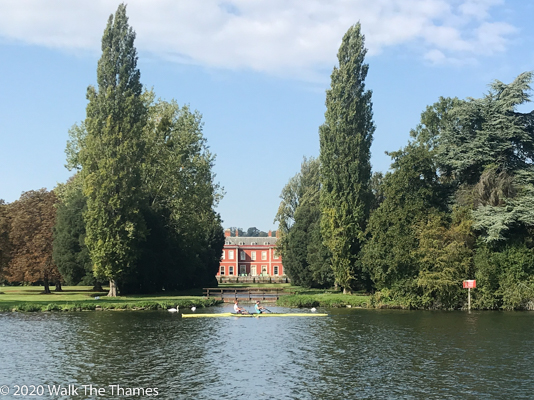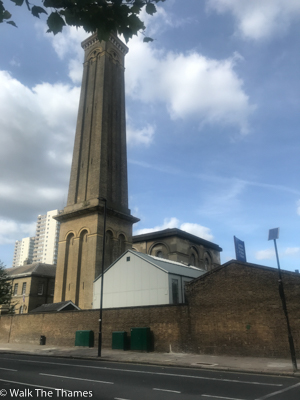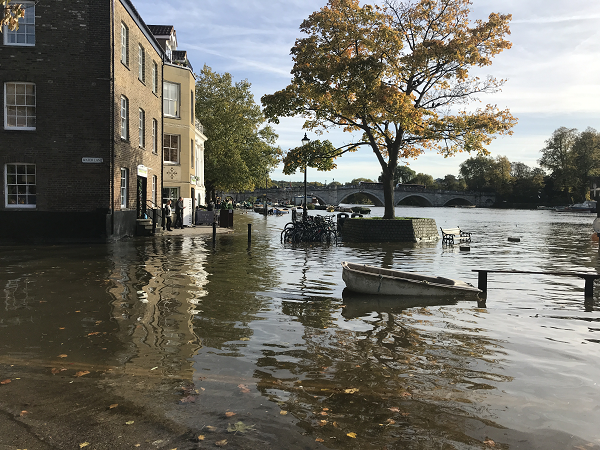The weather, which has been so wonderful these last few days, has now finally turned and we are definitely now in Autumn. The picture below was taken yesterday as we dropped bags off at the Leander Club in Henley. It’s probably the last “summer” photo of the year. The building is Fawley Court, one of three contenders (along with Hardwick House and Mapledurham House) for Toad Hall.

Hogarth’s House in Chiswick re-opened yesterday (22 September). William Hogarth (1696 – 1764) was a painter, engraver, cartoonist, satirist and social critic. His works often focused on morals, as typified by his series A Rake’s Progress, a series of eight paintings reproduced in print form, depicting the decline of Tom Rakewell who wastes his fortune on high living, liquor and women, ends up in a debtor’s prison. Although he lived in London he kept a “country retreat” in Chiswick which is now open to the public. Some of his works are maintained there. Tickets must be booked in advance.
A reminder that the Chelsea History Festival is currently ongoing.
The London Museum of Water and Steam, which is a few yards off-route in Brentford (if taking the left bank) is hosting an exhibition entitled Bygone Brentford. The museum is housed in a former pumping station and is home to a large collection of water pumping steam engines.
It is currently open Thursday to Saturday from 11am to 3pm

We have had enquiries as to the location of toilets along the route. We have therefore updated our maps to show these. Of course, in the current climate, we cannot guarantee that these will all be open. But, at least we tried!
We had our first flood alert this week for some months. This was tidal flooding in west London which caused some dampness around Putney. We don’t have a picture we can share but the photo below, which was taken in Richmond in similar conditions, will give you an idea of what tidal flooding can do.

At 76 miles from the source, Wallingford is a natural place to break your journey. It’s a market town with shops, bars, restaurants and even a small theatre housed in the Corn Exchange.
But it’s not just a filling station. Wallingford Castle was one of the most powerful royal castles of the 12th and 13th centuries. It was occupied by supporters of Empress Matilda, daughter of Henry I, who was challenging for the English throne against her brother, Stephen. Stephen frequently lay siege to the castle until, at the Treaty of Wallingford in 1153, it was agreed that Stephen would rule as King of England but, on his death, Matilda’s son, Henry (later Henry II), would ascend to the throne. The castle, a Royalist stronghold during the Civil War, was destroyed by Parliamentarians fearing it might be a catalyst for a Royalist revival.
Stopping in Wallingford provides you the opportunity to wander through the gardens that surround the remains of the castle. The existence of the castle is not obvious from the Thames Path but it would be a shame not to see it.
Away from the castle you can try the many bars, restaurants and independent shops. Why not stop at The Wallingford Bookshop? Agatha Christie lived here and you can learn more about her life here at the Wallingford Museum. And, if you are leaving the Thames Path here, there are buses to Oxford and Reading which depart from the town square.
Finally, we will be taking a short break from these articles so don’t be alarmed if you don’t hear from us for two weeks!
Ready to book?
| Cookie | Duration | Description |
|---|---|---|
| cookielawinfo-checkbox-analytics | 11 months | This cookie is set by GDPR Cookie Consent plugin. The cookie is used to store the user consent for the cookies in the category "Analytics". |
| cookielawinfo-checkbox-functional | 11 months | The cookie is set by GDPR cookie consent to record the user consent for the cookies in the category "Functional". |
| cookielawinfo-checkbox-necessary | 11 months | This cookie is set by GDPR Cookie Consent plugin. The cookies is used to store the user consent for the cookies in the category "Necessary". |
| cookielawinfo-checkbox-others | 11 months | This cookie is set by GDPR Cookie Consent plugin. The cookie is used to store the user consent for the cookies in the category "Other. |
| cookielawinfo-checkbox-performance | 11 months | This cookie is set by GDPR Cookie Consent plugin. The cookie is used to store the user consent for the cookies in the category "Performance". |
| viewed_cookie_policy | 11 months | The cookie is set by the GDPR Cookie Consent plugin and is used to store whether or not user has consented to the use of cookies. It does not store any personal data. |